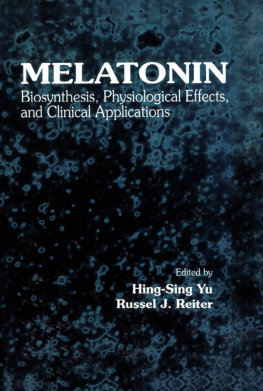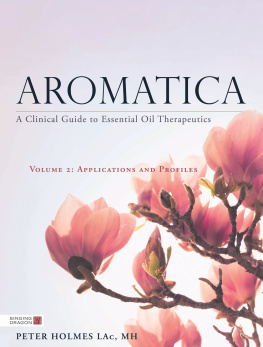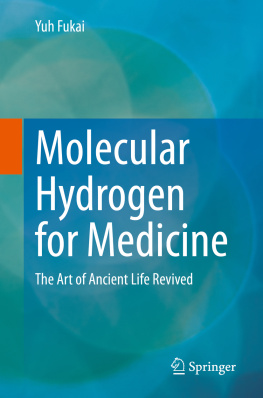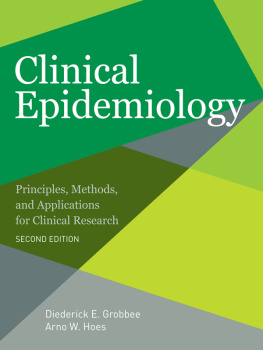Contents
Page List
MELATONIN
Biosynthesis, Physiological Effects, and Clinical Applications
Edited by
Hing-Sing Yu, Ph.D.
Director of the Biorhythm Research Laboratory
Division of Mathematics, Computer Science and Statistics
The University of Texas at San Antonio
San Antonio, Texas
Russel J. Reiter, Ph.D.
Professor of Neuroendocrinology
Department of Cellular and Structural Biology
The University of Texas Health Science Center at San Antonio
San Antonio, Texas
CRC Press
Taylor & Francis Group
6000 Broken Sound Parkway NW, Suite 300
Boca Raton, FL 33487-2742
1993 by Taylor & Francis Group, LLC
CRC Press is an imprint of Taylor & Francis Group, an Informa business
No claim to original U.S. Government works
This book contains information obtained from authentic and highly regarded sources. Reasonable efforts have been made to publish reliable data and information, but the author and publisher cannot assume responsibility for the validity of all materials or the consequences of their use. The authors and publishers have attempted to trace the copyright holders of all material reproduced in this publication and apologize to copyright holders if permission to publish in this form has not been obtained. If any copyright material has not been acknowledged please write and let us know so we may rectify in any future reprint.
Exceptas permitted under U.S. Copyright Law, no part of this book may be reprinted, reproduced, transmitted, or utilized in any form by any electronic, mechanical, or other means, now known or hereafter invented, including photocopying, microfilming, and recording, or in any information storage or retrieval system, without written permission from the publishers.
For permission to photocopy or use material electronically from this work, please access www.copyright.com (http://www.copyright.com/) or contact the Copyright Clearance Center, Inc. (CCC), 222 Rosewood Drive, Danvers, MA 01923, 978-750-8400. CCC is a not-for-profit organization that provides licenses and registration for a variety of users. For organizations that have been granted a photocopy license by the CCC, a separate system of payment has been arranged.
Trademark Notice: Product or corporate names may be trademarks or registered trademarks, and are used only for identification and explanation without intent to infringe.
Visit the Taylor & Francis Web site at
http://www.taylorandfrancis.com
and the CRC Press Web site at
http://www.crcpress.com
PREFACE
Melatonin is a neural hormone primarily secreted by the pineal gland; it has a profound influence on the internal environment of the organism with diverse physiological effects. This indole may play a role in reproduction, metabolism, seasonality, immunity, thermoregulation, and possibly the aging process. Melatonin has been postulated to be pathophysiologically associated with cancer, epilepsy, seasonal affective disorder, and ocular diseases. Since the first isolation of melatonin from the bovine pineal in 1958, we have witnessed an exponential increase in research activity related to this hormone. Considering the vast amount of data from recent studies, investigators in the field would benefit from a complete literature review of the biochemical and molecular aspects of melatonin, as well as its physiological effects and possible clinical applications. The aim of this book is to provide comprehensive reviews in these major areas of melatonin research in a single reference source for researchers from different backgrounds with a common interest in the multiple functions of melatonin.
Although the emphasis in the present book is on melatonin instead of the pineal gland, previous volumes on pineal research are indispensable. A classic work, The Pineal, written by Wurtman, Axelrod, and Kelly, was published in 1968. A series of three volumes entitled The Pineal Gland and edited by Reiter was published in 1981 by CRC Press and has served the biomedical community well. Additionally, an annual publication entitled Pineal Research Reviews, published by Alan R. Liss, provided an important source of pineal-related information until about five years ago. Since then, several symposium proceedings have appeared under the title of Advances in Pineal Research, published by John Libbey. These have kept pineal scientists current with research information from the field. These above contributions to the field of pineal research serve as a backdrop for this volume, which is dedicated to the chief pineal hormone, melatonin.
The editors are indebted to the staff of CRC Press for initiating the idea for the current volume and for inviting us to serve as the editors. We thank the contributors for taking time from their very busy schedules to prepare their reviews. We are also grateful to Dr. K. W. Lam, Professor of Ophthalmology, for his recommendation, and to many other colleagues who have made suggestions and comments in terms of what should be included in the volume. Finally, we greatly appreciate the enthusiastic help of the administrative and secretarial staff in our departments. After reading the chapters and noting the ubiquitous actions of melatonin, the reader may find the following statement valid: he (she) who knows melatonin, knows medicine.
H. S. Yu
R. J. Reiter
THE EDITORS
Hing-Sing Yu, Ph.D., is Director of the Biorhythm Research Laboratory, Division of Mathematics, Computer Science, and Statistics at the University of Texas at San Antonio. He graduated from the University of Hong Kong with Bachelor of Science degree in 1979. He received his Masters and Ph.D. degrees in reproductive and developmental biology at the same university. In 1988, Dr. Yu came to the United States as a Research Instructor in the Department of Ophthalmology at the University of Texas Health Science Center at San Antonio, and later became Assistant Professor. In 1991, he joined the College of Science and Engineering at the University of Texas at San Antonio to teach statistics, applied mathematics, reproductive biology, and cytodifferentiation, and he established the Biorhythm Research Laboratory for interdisciplinary studies. He is also cross-appointed as Assistant Professor in the Departments of Physiology and Ophthalmology at the Health Science Center. Dr. Yu is a member of the American Association for the Advancement of Science, American Society for Cell Biology, Association for Research in Vision and Ophthalmology, International Society for Eye Research, Society for the Study of Endocrinology, Metabolism and Reproduction, Society for the Study of Reproduction and Fertility, and the Tissue Culture Association. He has been invited to give seminars and lectures in his research area and to write reference books on subjects he teaches for undergraduate and graduate students. His current research interests include cell culture and computational models in rhythmic biological processes such as melatonin rhythms and cell proliferation.
Russel J. Reiter, Ph.D., is Professor of Neuroendocrinology in the Department of Cellular and Structural Biology at the University of Texas Health Science Center at San Antonio. Dr. Reiter received his Bachelor of Arts degree from St. Johns University, Collegeville, Minnesota, and his Masters and Ph.D. degrees from The Bowman Gray School of Medicine at Wake Forest University, Winston-Salem, North Carolina. Subsequently, Dr. Reiter has received two honorary D. Med. degrees (Doctor honoris causa), one each from the Medical Academy of Lodz, Lodz, Poland, and from the University of La Laguna, La Laguna, Spain. In addition to these two honors, Dr. Reiter has received many other awards, including the National Institutes of Health (NIH) Career Development Award, the A. Ross McIntyre Gold Medal and Award, and the U.S. Senior Scientist von Humboldt Award. Dr. Reiter has published more than 650 original research papers, reviews and chapters. He has served on the Editorial Board of 22 journals during his career, including








